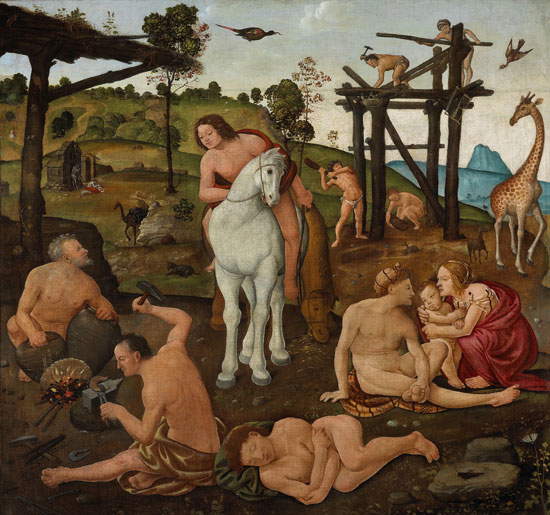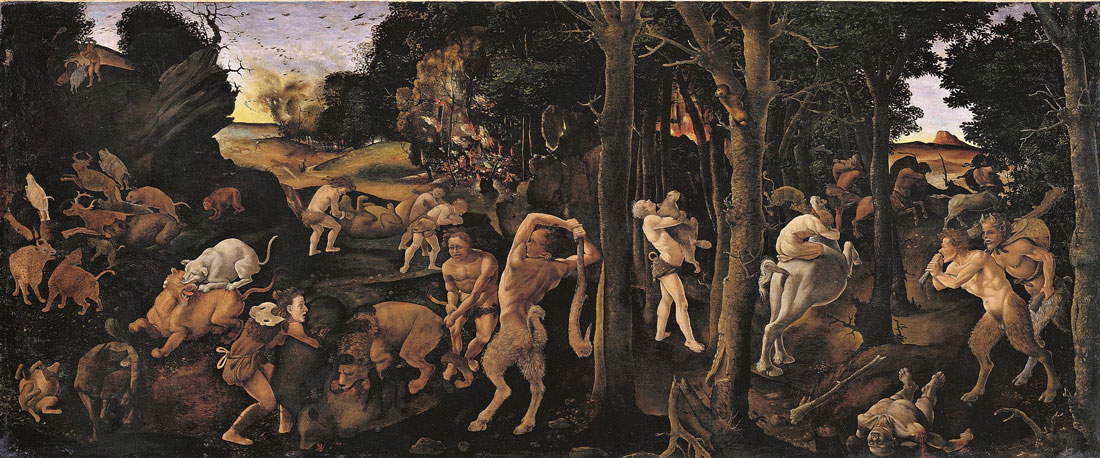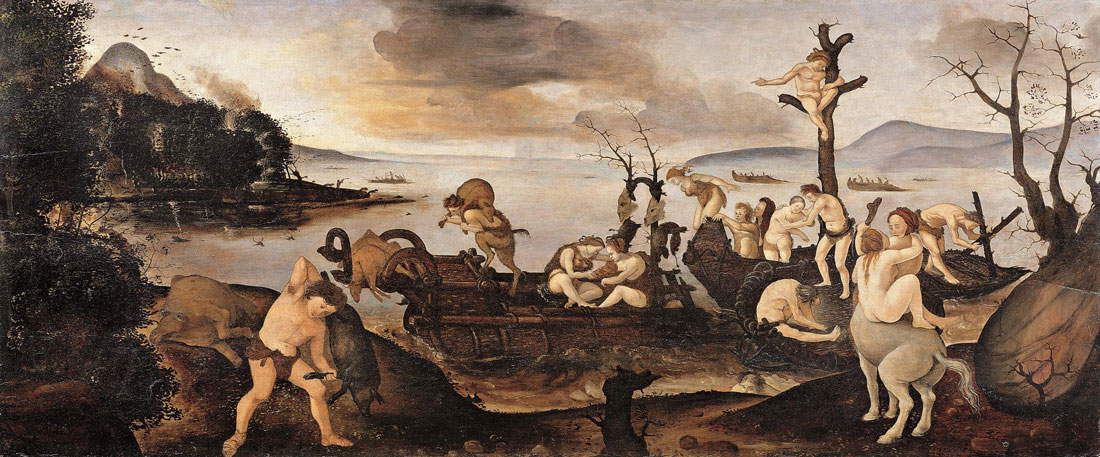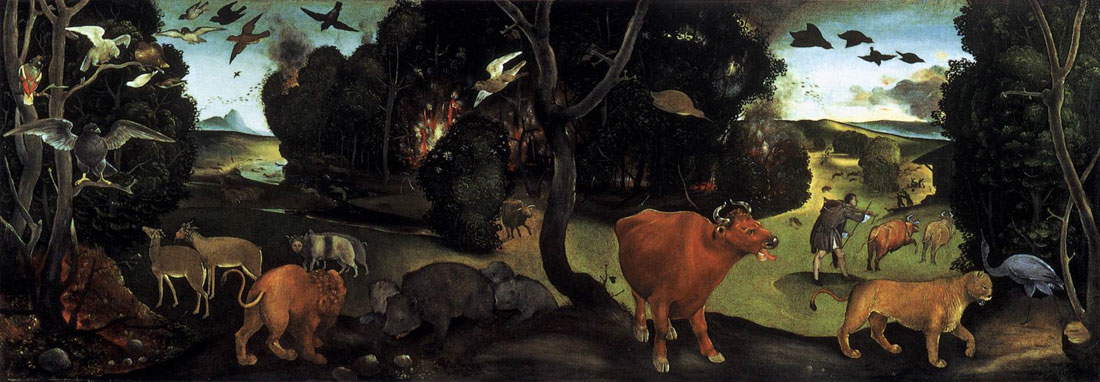The recent exhibition on Piero di Cosimo (1462 - 1522) at the Uffizi (and, even before the latter, the immediately preceding retrospective held at the National Gallery in Washington) had, among others, the merit of bringing together a good part of the paintings pertaining to the so-called "Cycle of Human Prehistory," which was the subject of one of the most celebrated essays in twentieth-century art history: Human Prehistory in Two Painting Cycles by Piero di Cosimo, by Erwin Panofsky (1892 - 1968), published in Italy in the volume Studi di iconologia, a true classic of art history. The essay, originally published in 1939, provided an indispensable basis for understanding the meaning of these paintings with their somewhat unusual, but very interesting content: obviously, in the following years Panofsky’s essay has undergone criticism and reinterpretation also due to certain inconsistencies that would seem to connote the writing, but in this article we would like to focus precisely on the interpretation that the great German-U.S. scholar gave of Piero di Cosimo’s cycle, referring precisely to the Italian edition published in Einaudi’s Studi di Iconologia (from which all the quotation marks that follow in the article are taken, except where otherwise specified).
Panofsky starts from an observation: the subject of Piero di Cosimo’s painting preserved at the Wadsworth Atheneum in Hartford, Connecticut, does not seem to him to be able to be interpreted, as had been done until before his hypotheses, as “a representation of the myth of Ila and the nymphs.” There are too many inconsistencies with the myth, which told of how Ila and Hercules had momentarily abandoned the Argonauts’ expedition, of which they were part, in order to find a tree to build a new oar for Hercules: Ila, having gone near a river to draw water, would have been approached by the Naiads, the sea nymphs who, having fallen in love with him because of his attractiveness, would have kept him with them and would not have allowed him to rejoin Hercules. Hartford’s painting lacks several details that would allow the subject to be traced back to that myth: the water vessels, the river, the “loving aggression on the part of the Naiads,” the “reluctant struggling on the part of Ila.” Panofsky, noting the deformed limbs of the young boy in the center of the scene (particularly his bowed legs), and noting the attention the youths pay to the boy, was led to believe that the subject could only be the finding of Vulcan: according to the myth, the god of fire was allegedly hurled down from Olympus (although the various versions of the story do not agree on the reason for the fall) and, having taken refuge on the island of Lemno, was welcomed and cared for by its inhabitants. For Panofsky, this is the true subject of the painting.

Referring back to classical writings (in particular, to Vitruvius: we will discuss this in more detail in a moment), Panofsky locates the god Vulcan in another painting by Piero di Cosimo, preserved in Ottawa at the National Gallery of Canada. In particular, the god would be traced in the moreover highly characterized figure (a detail that led Panofsky to think that the character bore the features of the probable patron, the wealthy Florentine Francesco del Pugliese), of the blacksmith intent on the anvil in the lower left corner of the composition. The young man on horseback in the center of the scene peering at Vulcan’s activity would be interested in the very object he is forging: a horseshoe. The old man next to Vulcan would be the god Aeolus: since air fuels fire, the ancients believed that Vulcan had his workshop near Mount Etna, thus not far from Lipari where, according to myth, Aeolus dwelt. The figures, bottom right, of the sleeping young man and the little family could be explained, according to Panofsky, on the basis of a passage from Virgil’sAeneid, in which the poet describes Vulcan as a “great smith” who is already at work in the early morning, while there are those who are still asleep (like the young man) or are just waking up, like the little family. This detail would also help to place the time of day in which the scene takes place: precisely, the first light of dawn. This is a detail of no small importance, because it would also hold a precise symbolic detail: it is, in fact, the"dawn of civilization.“ In other words, Vulcan is to be considered the ”first master of human civilization," the god who teaches primitive men the arts and crafts: and this is well demonstrated to us by the group, more backward, intent on building with some tools (nails, hammers, clubs) a rudimentary hovel with unsquared wooden beams. The Ottawa painting, which can also be considered a pendant of the Hartford one by virtue of its entirely similar and nearly corresponding dimensions, would constitute the moment in the narrative subsequent to that described in the Finding of Vulcan. Panofsky, therefore, believes (albeit with all due caution: he himself considers his hypothesis “debatable matter”) that Piero di Cosimo’s two canvases belong to a single cycle, to which the scholar adds a third painting depicting Mars and Venus with her Loves and Vulcan, thought to be lost but mentioned by Giorgio Vasari.

Panofsky, however, goes further, believing that the two Hartford and Ottawa paintings may themselves be chapters in a larger narrative intended to tell the story of early humanity. If, therefore, the above two works are to be seen as an "interpretation of the era sub Vulcanum" (under Vulcan), there would be three panels to be considered illustrative of an era ante Vulcanum (before Vulcan): a time when humanity would have led an existence in a “genuinely bestial” state, elevated later through “technical and intellectual progress.” This evolutionary conception of human history, which “imagines the rise of humanity as an entirely natural process, due solely to the innate endowments of the human race, whose civilization would have begun with the discovery of fire,” was reflected in a passage from Vitruvius (taken from the second book De architectura), itself in any case indebted to Lucretius, in which he speaks of a humanity that, in ancient times, led a beast-like life: primitive humans dwelt in forests and caves and fed on what they found. During a storm, some felled trees, colliding with each other, would catch fire: the men, at first appalled by the force and noise of the fire, would then approach each other as they were aware of the comforts the fire would afford. Thus having to show each other the practical applications of fire, primitive men would create language, driven by the need to name things. These were the premises, for Vitruvius, of the birth of techniques and the arts.
Panofsky believes that Vitruvius’ passage describing the priscorum hominum vita, the life of primitive men, can meanwhile be read as a kind of reinterpretation of the Vulcan myth, and above all that it was well represented by Piero di Cosimo in three panels, all of the same size (except for one, which is about thirty centimeters longer) and preserved at the Metropolitan Museum in New York (the Hunting Scene and the Return from the Hunt) and at theAshmolean Museum in Oxford (the Landscape with Animals). In the first painting, the Hunting Scene, a primitive humanity is engaged in a furious “all against all” fight, clear evidence of the evolutionary stage of the humans depicted in the scene. A feral humanity (in fact, some characters have the features of satyrs) that kills animals with bare hands or, at most, with heavy clubs, that rides in wrong positions, that ignores the use of fire. Fire is also present in the painting: theforest fire represents a kind of leitmotif of the cycle, which can be explained on the basis of the hypothetical fire “that haunted the imagination of Lucretius, Diodorus Siculus, Pliny, Vitruvius, and Boccaccio” and was believed to have been the event that would allow humanity to discover fire. There is no shortage of macabre details, such as the corpse in the foreground, or the carcasses of animals bitten by beasts that rush in and in turn engage in fights with humans.



The second painting in the series represents a later stage of evolution. The struggle that characterized the first panel in the Metropolitan has subsided, and humanity has begun to work together to hunt. And to go hunting (or rather, in this case to return from the hunt) humans use rudimentary boats made from appropriately hollowed but crudely crafted logs: see only the mast of the boat, which is nothing more than a log hoisted up haphazardly, on which one of the hunters climbs. We also see other similar boats in the waters in the background: a background on which, moreover, the forest fire motif returns (we see it on the left). The successful outcome of the hunt is evidenced by the boars that some of the hunters are unloading from the boat. We are, however, still a long way from civilization proper: the men are still unfamiliar with techniques and crafts, and they still roam around naked or, at best, clad in untanned skins.
In the last panel, the Landscape with Animals, “one of the earliest truly landscape paintings in postclassical art,” animals, unlike humans, still flee at the sight of fire, and we still have hybrid creatures (in particular, a sow with a woman’s face and a goat with a man’s face) explicable, according to Panofsky, on the basis of bestial mating between humans and animals that would have connoted primitive humanity. However, humanity has made significant progress: we see a hidden hut in the forest, there are characters tinkering with some vessels, we have a man dressed in a kind of leather suit who takes advantage of the fire, in front of which he appears completely indifferent, to lead a couple of cows to the hut.
These are three extremely imaginative panels, the product of a bizarre ingenuity such as Piero di Cosimo’s was: three panels that, according to Panofsky, are placed immediately before, iconographically speaking, the Hartford and Ottawa paintings in which, as we have seen, the god Vulcan, in his guise of “master of humanity,” is said to have enabled human beings to set out on the road to civilization and technological progress. Following what has been said so far, for Panofsky it would not be far-fetched (or, at any rate, it would certainly be pleasing) to speculate that all five paintings (six, including the lost one) were conceived as parts of a single cycle, executed for the same patron, perhaps with the purpose of decorating two rooms: in an antechamber the three small panels, those of humanity ante Vulcanum, and in a larger hall the canvases with the stories of Vulcan. Of course: as we said in the opening, many have challenged Panofsky on several inconsistencies. To give a few examples: the light in the Ottawa painting cannot be considered that of dawn, which should lead art historians to change their opinion about the characters close to Vulcan, or the human-faced animals that could not be explained by referring to Lucretius, who in his De rerum natura ruled out the existence in ancient times of hybrid creatures, or even the unresolved location of a panel depicting a Construction of a Building, preserved at the Ringling Museum in Sarasota, Florida (and exhibited, moreover, alongside paintings of the prehistory of humanity in the Florentine exhibition), which is not mentioned in Panofsky’s essay. The great scholar’s hypotheses, however, still retain their appeal today, especially when analyzed in consideration of Piero di Cosimo’s peculiar character.
In his Lives, Giorgio Vasari tells us that the Florentine painter “held a life of a man more bestial than human. He did not want the rooms to be swept, he wanted to eat at the hour that hunger came, and he did not want the fruits of the garden to be hoed or pruned, rather he let the vines grow et go the shoots on the ground, et the figs were never pruned, nor the other trees, rather he was content to see everything saved as his nature, alleging that the things of it nature should be left to her to guard without doing anything else to them.” Urban life annoyed him, he derived more enjoyment from the company of animals than from the company of men, he had bizarre eating habits. In short, a man so bestial that “he was more to be kept mad, still that he did no harm except to himself alone.” Panofsky is convinced that it is precisely in the adjective “salvatico,” used by Vasari, that we should trace the key to understanding the cycle of human prehistory. Because Piero di Cosimo’s nature, typical of “a primitive who happened to live in a period of exquisite civilization,” would have led him to create representations that would not, for Panofsky, be the result of fantasies, or attempts at idealization: they would be scenes of primitive life whose subconscious memory would seem to resurface in Piero di Cosimo’s mind, which would thus be able to provide us “with the utmost realism and concreteness” paintings depicting the life of primitive men. With a very clear objective: to convey the conviction that happiness is possible only as long as man remains in contact with nature.
Warning: the translation into English of the original Italian article was created using automatic tools. We undertake to review all articles, but we do not guarantee the total absence of inaccuracies in the translation due to the program. You can find the original by clicking on the ITA button. If you find any mistake,please contact us.